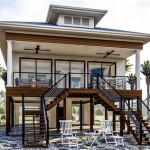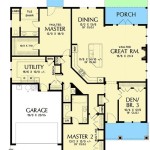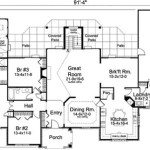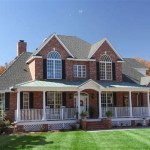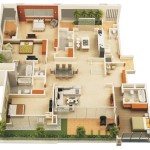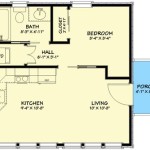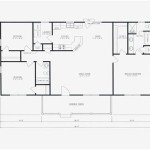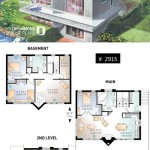Contemporary House Plans: The Allure of One-Story Living
Contemporary house plans, characterized by clean lines, open spaces, and an emphasis on natural light, are increasingly popular choices for homeowners. Among these designs, one-story contemporary house plans hold a unique appeal, offering accessibility, ease of maintenance, and a seamless connection to the outdoors. This article will delve into the key aspects of contemporary one-story house plans, exploring their benefits, design considerations, and common features.
Accessibility and Universal Design Principles
One of the primary advantages of a one-story contemporary house plan lies in its inherent accessibility. Eliminating the need for stairs makes the home suitable for individuals of all ages and abilities. This is particularly beneficial for families with young children, elderly individuals, or those with mobility limitations. The single-level layout promotes independent living and reduces the risk of falls and injuries.
Moreover, one-story designs are easily adaptable to incorporate universal design principles. Universal design aims to create spaces that are usable by everyone, regardless of their age, size, or ability. This can include features such as wider doorways and hallways to accommodate wheelchairs or walkers, lever-style door handles for easier gripping, and roll-in showers for barrier-free bathing. Integrating these elements into a contemporary one-story plan ensures that the home remains functional and comfortable for the long term, accommodating changing needs and life stages.
Beyond physical accessibility, a one-story layout often fosters a greater sense of connection and community within the home. Open floor plans allow for easy flow between living spaces, promoting interaction and facilitating social gatherings. Parents can easily supervise children while cooking or working, and family members can effortlessly engage in shared activities. The absence of stairs also contributes to a more cohesive and unified living environment.
Additionally, maintaining a one-story home is generally easier than a multi-story dwelling. Cleaning, repairs, and renovations are simplified when everything is on the same level. There is no need to carry heavy equipment or materials up and down stairs, reducing the physical strain and making home maintenance more manageable. This can be a significant advantage for busy homeowners or those seeking to minimize the burden of upkeep.
Energy Efficiency and Sustainable Design
Contemporary one-story house plans often lend themselves well to energy-efficient and sustainable design strategies. The relatively compact footprint of a single-level home can reduce heating and cooling costs compared to a larger, multi-story structure. Moreover, the orientation of the house can be optimized to maximize natural light and minimize solar heat gain, further reducing energy consumption.
Strategic placement of windows and skylights can harness natural light to illuminate interior spaces, reducing the need for artificial lighting during the day. Overhangs and awnings can provide shade during the hottest parts of the day, preventing excessive heat buildup. Careful consideration of window glazing can also improve energy efficiency by minimizing heat transfer.
Sustainable building materials, such as recycled content siding, sustainably harvested wood, and low-VOC paints, can be incorporated into the design to reduce the environmental impact of the home. Energy-efficient appliances and fixtures, such as LED lighting, water-saving toilets, and Energy Star-rated appliances, can further reduce energy and water consumption.
The roof of a one-story home offers a large surface area that is ideal for installing solar panels. Solar panels can generate electricity to power the home, reducing reliance on fossil fuels and lowering energy bills. Green roofs, which are covered with vegetation, can also be incorporated into the design to provide insulation, reduce stormwater runoff, and create a habitat for wildlife.
Water conservation is another important aspect of sustainable design. Rainwater harvesting systems can collect rainwater for irrigation or non-potable uses, such as flushing toilets. Drought-tolerant landscaping can reduce water consumption and minimize the need for irrigation. Graywater recycling systems can reuse wastewater from showers and sinks for irrigation, further reducing water usage.
Seamless Connection to the Outdoors
Contemporary one-story house plans excel at creating a seamless connection between indoor and outdoor living spaces. Expansive windows, sliding glass doors, and patios blur the lines between the interior and exterior, allowing homeowners to enjoy the beauty and tranquility of nature. This connection to the outdoors can enhance well-being, reduce stress, and improve overall quality of life.
Large windows and sliding glass doors provide ample natural light and panoramic views of the surrounding landscape. These features can also create a sense of spaciousness and openness, making the interior feel larger and more inviting. Outdoor living spaces, such as patios, decks, and courtyards, extend the living area outdoors, providing space for relaxation, entertaining, and dining.
Consider designing outdoor living spaces that are directly accessible from the main living areas of the home. This creates a natural flow between the interior and exterior, making it easy to move between spaces. Outdoor kitchens, fireplaces, and seating areas can further enhance the functionality and enjoyment of outdoor living spaces.
Landscaping plays a crucial role in creating a cohesive and harmonious connection between the home and the surrounding environment. Native plants, trees, and shrubs can create a natural and inviting landscape that blends seamlessly with the surroundings. Water features, such as ponds and waterfalls, can add a soothing element to the outdoor space.
Privacy is also an important consideration when designing outdoor living spaces. Strategically placed fences, hedges, or trees can provide privacy from neighbors and create a sense of seclusion. Consider the orientation of the outdoor spaces to maximize sunlight and minimize wind exposure.
The careful integration of indoor and outdoor spaces can transform a contemporary one-story house plan into a truly exceptional living environment. By blurring the lines between the interior and exterior, homeowners can enjoy the beauty and tranquility of nature year-round.
In summary, contemporary one-story house plans offer a compelling combination of accessibility, energy efficiency, and a strong connection to the outdoors. These designs are suitable for a wide range of homeowners, from those seeking a home for their retirement years to families with young children. By carefully considering the design principles outlined above, homeowners can create a contemporary one-story house plan that meets their specific needs and preferences, providing them with a comfortable, functional, and aesthetically pleasing living environment.

Small One Story 2 Bedroom Retirement House Plans Houseplans Blog Com

Single Story Modern House Plans Designs 87651 Contemporary Design Facade Exterior

Kelso A Modern One Story House Plan With Country Kitchen 5173

1 Story Contemporary Ranch House Plans With 2 Bedrooms

1 Story House Plans One Modern Luxury Home Floor

Plan 81235 One Story Modern House With 3 Bedrooms

10 Simple Floor Plans For House Builders Blog Eplans Com

One Story Mid Century Modern Style House Plan 5880 The Westerly

Best One Story House Plans And Ranch Style Designs

Small One Story 2 Bedroom Retirement House Plans Houseplans Blog Com

